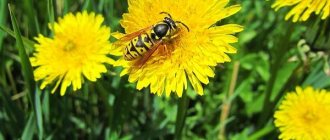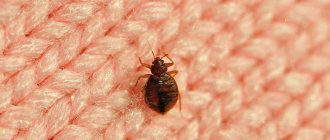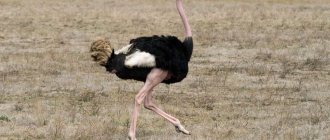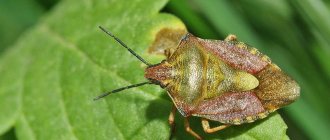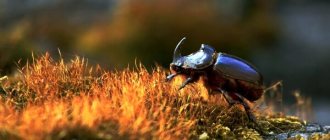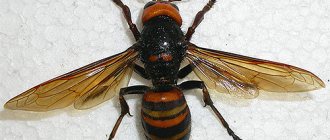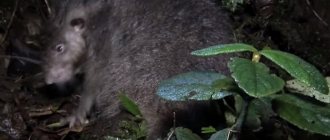- home
- Rat
- Varieties
07/07/2019 Black rats are a species of mammal of the rodent order, the Latin name of the species is Rattus rattus. Humanity became acquainted with black rats much earlier than with gray pasyuki; It was the animals with dark fur coats that became constant passengers on ships. They were the first of the rodents to infest European territory in the Middle Ages, becoming a nightmare for both rural and urban residents. Later, the animals gave up their positions - pasyuki became the number 1 pest. Nowadays, black rats are found both as wild rodents and as pets.
Appearance
In appearance, the brunettes of the mouse family differ from their gray relatives, pasyuks, not only in their dark colors, but also in their smaller dimensions. The black rat has the following parameters:
- weight – up to 300 g;
- body length – up to 22 cm;
- tail length – up to 29 cm.
The length of the animal's tail always exceeds the length of the body.
The animal's muzzle is elongated, with expressive round beady eyes. Rat ears are similar to mouse ears:
- small size;
- round shape;
- wide at the base.
The coat of a black rat is divided into two layers:
- lower – undercoat;
- the top one is a long, hard pile.
The color is usually deep black with a green tint. But sometimes there are individuals with dark gray fur, almost like pasyuks. The richness of the color is associated with the region where the animal lives - the inhabitants of the north have a black fur coat, and the inhabitants of the south have a dark gray coat. On the sides, the fur is always several tones lighter than the main color.
The tail is scaly, completely covered with long dark hairs. The tip of the tail is decorated with a barely noticeable tassel.
Appearance
According to encyclopedic data, the black rat is a representative of the smallest rats living in Russian regions. The body length is 16-22cm. The weight of this type of rodent ranges from 100 to 350 grams. The tail is longer than the animal's body. Males are much larger in size than females. The color of rodents varies from black to the lightest shade of brown. The fur of the rat has a metallic sheen, and the abdomen is characterized by an ashen or gray color with a dirty tint. The black rat's muzzle is narrow, it has large ear shells, a well-formed neck, and a long, flexible tail.
Where do the animals come from?
Fossil remains discovered by archaeologists indicate that the original habitats of black rodents were the Mediterranean and Middle Eastern territories. The animals managed to spread throughout the world thanks to their “love” for sea travel - they penetrated into remote territories from ships. In ancient times, black rodents were already found on almost all continents of the globe. The exploration of Russian lands by dark animals dates back to the beginning of the 17th century.
Subspecies
The black rodent family includes several species:
- Asian;
- oceanic;
- Mauritian;
- Ceylonese
They differ mainly in distribution. If individuals of the Asian subspecies live everywhere on the planet, then Ceylon ones are found exclusively on the island of Sri Lanka.
References
- ^ a b
Krysztufek, B.;
Palomo, L.J.; Hutterer, R.; Mitsain, G. and Yigit, N. (2015). " Rattus rattus
".
IUCN Red List of Threatened Species
.
2015
: e.T19360A115148682. - Baig, Mumtaz; Khan, Shiba; Impatient, Heidi; Atkulwar, Ashwin; Searle, Jeremy B. (February 2022). "Phylogeography of the black rat Rattus rattus in India and implications for its dispersal history in Eurasia." Biological invasions
.
21
(2):417–433. Doi:10.1007/s10530-018-1830-0. ISSN 1387-3547. - Linnaeus, C. (1758). " Mus rattus
".
Caroli Linnæi Systema naturæ per regna tria naturæ, minor classes, ordinal, genera, species, cum characteribus, differentials, synonyms, loci.
Tomus I (in Latin) (Decima, reformatted ed.). Holmiae: Lavrentius Salvius. paragraph 61. - "Black Rat, House Rat, Roof Rat, Ship Rat ( Rattus rattus
)."
WAZA.org
. Archived from the original on October 19, 2016. Retrieved October 19, 2016. - Gillespie, H. (2004). " Rattus rattus
is a house rat."
Animal Diversity Network
. - Schwartz, Charles Walsh and Schwartz, Elizabeth Reeder (2001). Wild Mammals of Missouri
, University of Missouri Press, ISBN 978-0-8262-1359-4, paragraph 250. - Engels, Donald W. (1999). Classic Cats: The Rise and Fall of the Sacred Cat
, Routledge, ISBN 978-0-415-21251-9, para. 16. - Alderton, D. (1996). Rodents of the world
. Publishing. ISBN 0-8160-3229-7 - Rackham, J. (1979). " Rattus rattus
: The introduction of the black rat to Britain."
Antiquity
.
53
(208): 112–120. doi:10.1017/s0003598×00042319. PMID 11620121. - McCormick, M. (2003). "Rats, Communications, and Plague: Toward an Ecological History" (PDF). Journal of Interdisciplinary History
.
34
(1): 1–25. Doi:10.1162/002219503322645439. - Schmid, B.V.; Büntgen, U.; Easterday, W.R.; Ginzler, C.; Walløe, L.; Bramanti, B.; Stenseth, N. C. (2015). "The climate-driven introduction of the Black Death and successive reintroductions of plague into Europe." Proceedings of the National Academy of Sciences of the United States of America
.
112
(10):3020–3025. Bibcode:2015PNAS..112.3020С. doi:10.1073/pnas.1412887112. PMC 4364181. PMID 25713390. - ^ a b c d e
Marsh, Rex E. (1994).
"Rats". Wildlife Damage Control Online Center
. Prevention and control of damage to wildlife. Archived from the original on May 21, 2011. Retrieved April 22, 2011. - ^ a b
Bennett, Stuart M. "Black Rat (
Rattus Rattus
)."
Pied Piper
. Retrieved April 22, 2011. - ^ a b
"
Rattus rattus
- Rat on the roof."
Wildlife Information Network
.
Retrieved April 22, 2011. [ permanent dead link
] - Donald W. Engels (1999). Classic Cats: The Rise and Fall of the Sacred Cat
. Rutledge. paragraph 111. ISBN 978-0-415-21251-9. - Teisha Rowland (December 4, 2009). "The Ancient Origin of Domestic Rats". Santa Barbara Independent
. Archived from the original on September 24, 2015. - "Nova: Attack of the Rats." New star
. April 7, 2010 PBS. - Evans, Ondine (1 April 2010). "Animal Species: Black Rat." Australian Museum website
. Sydney, Australia: Australian Museum. Retrieved December 31, 2010. - ^ a b c
Dowding, J. E. & Murphy, E. C. (1994).
"Ecology of ship rats ( Rattus rattus
) in kauri (
Agathis australis
) forest in Northland, New Zealand" (PDF).
New Zealand Journal of Ecology
.
18
(1): 19–28. - Cox, M.P.G.; Dickman, C. R. & Cox, W. G. (2000). "Habitat use by the black rat ( Rattus rattus
) at North Head, New South Wales: an observational and experimental study."
Australia Ecology
.
25
(4): 375–385. Doi:10.1046/j.1442-9993.2000.01050.x. - ^ a b
Clark, D. A. (1982).
"Feeding of omnivorous vertebrates ( Rattus rattus
): Feeding structure, sampling, and diet breadth."
Ecology
.
63
(3):763–772. doi:10.2307/1936797. JSTOR 1936797. - Hafidzi, MN.; Close, F.A.A. & Saadia, A. (2007). “Ectoparasites Rattus
sp.
from Petaling Jaya, Selangor, Malaysia." Pertanika Journal of Tropical Agriculture
.
30
(1): 11–16. - Meerburg, B. G., Singleton, G. R., Keilstra A. (2009). "Diseases transmitted by rodents and their risks to public health." Crit Rev Microbiology
.
35
(3):221–270. Doi:10.1080/10408410902989837. PMID 19548807.CS1 maint: several names: list of authors (link to site) - Finally, John M. “The Black Death,” Encyclopedia of Public Health
, eNotes online site. Retrieved December 31, 2010. - Barnes, Etne (2007). Disease and Human Evolution
, University of New Mexico Press, ISBN 978-0-8263-3066-6, paragraph 247. - Bollet, Alfred J. (2004). Plague and Smallpox: The Impact of Human History on Epidemic Diseases
, Demos Medical Publishing, 2004, ISBN 978-1-888799-79-8, paragraph 23 - Carrick, Tracy Hamler; Carrick, Nancy and Finsen, Lawrence (1997). The Pen of Persuasion: An Integrated Approach to Reasoning and Writing
, Jones and Bartlett Learning, 1997, ISBN 978-0-7637-0234-2, para. 162. - Hayes, J. N. (2005). Epidemics and Pandemics: Their Impact on Human History
, ABC-CLIO, ISBN 978-1-85109-658-9, para. 64. - Boschert, Ken (27 March 1991). "Bacterial diseases of rats." Net Vet and the electronic zoo
. Archived from the original on October 18, 1996. Retrieved April 22, 2011. - Grant-Hoffman, Minnesota; Mulder, C.P.; Belingham, P.J. (2009). "Invasive rats alter woody seedling composition on New Zealand islands dominated by seabirds." Oecologia
.
163
(2):449–60. doi:10.1007/s00442-009-1523-6. ISSN 1442-9993. PMID 20033216. - Chiba, S. (2010). "Invasive rats alter assembly characteristics of land snails on the Ogasawara Islands." Biological conservation
.
143
(6):1558–63. doi:10.1016/j.biocon.2010.03.040. - ^ a b
Vern, K;
McGrath, K. (2009). "Introduced black rats ( Rattus rattus
) Functional replacement for native mycophagous rodents in fragmented forests?
" Fungal ecology
.
2
(3): 145–48. doi:10.1016/j.funeco.2009.03.001. - Pride, M; Dilks, P; Fraser, Ian (2005). "Home range of ship rats ( Rattus rattus
) in a beech forest in the Eglinton Valley, Fiordland, New Zealand: an experimental study."
New Zealand Journal of Zoology
.
32
(3): 139–42. Doi:10.1080/03014223.2005.9518406. - Jackson, Michael; Hartley, Stephen; Linklater, Wayne (1 June 2016). “The best food baits and baits for invasive rats Rattus spp. And the brush-tailed possum Trichosurus vulpecula: biotest for wild, free-ranging animals.” Journal of Pest Science
.
89
(2):479–488. Doi:10.1007/s10340-015-0693-8. ISSN 1612-4766. - Innes, J; Warburton, B; Williams, D; and others. (1995). "Large-scale poisoning of ship rats ( Rattus rattus
) in native forests of the North Island, New Zealand" (PDF).
New Zealand Journal of Ecology
.
19
(1): 5–17. - Wege, David (August 4, 2010) Hábitat del Lagartijo del Seco Anolis Cooki Restaurant in Isla de Cardona and Cayo Ratones. birdlife.org.
- ^ a b
"RSPB: Shiant Islands Seabird Recovery Project".
www.rspb.org.uk.
_ Retrieved August 11, 2016. - "NBN Gateway - Tucson." data.nbn.org.uk.
_ Retrieved August 11, 2016.
Habitats
The favorite places of residence of rodents are ships and sea vessels. For them, these dwellings are ideal, since they combine the two main preferences of animals regarding housing - proximity to humans and water.
These animals try to settle close to people. Also, when choosing a place of residence, they give preference to areas near water bodies. But unlike pasyuks, brunette rats do not have a special attachment to water, so they often choose to settle in places such as:
- forests;
- edges;
- fields.
In an urban environment, the animal settles in the following places:
- abandoned buildings;
- trash cans;
- garages;
- entrances.
Also, dark rats settle in human houses, inhabiting the attic or upper tiers.
Life of rodents
They do not dig holes in the ground, but build nests in trees. A rat's building is similar to a magpie's nest. There are often cases when animals move into a ready-made nest, having first eaten its inhabitants.
Excellent climbing abilities allow black rats to move freely on both horizontal and vertical surfaces. The animals are able to climb to the very top of the tree, but they climb so high only when absolutely necessary.
During the day, black rats sit at home, hiding from sunlight, and under the cover of night they go in search of food. Caution is the key to any activity for a rodent. This is due to the large number of predatory enemies - animals with dark fur coats are eaten:
- birds;
- cats;
- dogs;
- hedgehogs;
- foxes;
- wolves.
The average lifespan of a wild rodent is 1-1.5 years. A decorative black rat kept as a pet can live for 4 years.
Fighting methods
Relocation closer to a person’s home occurs when unfavorable conditions occur - lack of food, premature cold snap, forest fires.
- In gardens, trees are tied with belts to prevent rats, and glue or resin is applied.
- For destruction, traps and traps are placed on the summer cottage.
- Chemicals are used on the territory of the house - poisonous baits, powders, dusts, and traps are built.
- If the premises are severely infested, specialists are called in.
Black rats are not characterized by seasonal population fluctuations. There are no widespread outbreaks of infection observed. It is advisable to use repellent methods to control pests. They use herbs, substances with a pungent odor, and repellent devices.
Diet
A black rat can hardly be called a predator. The animal mainly feeds on food of plant origin:
- grain;
- seeds;
- vegetables;
- fruits.
The proportion of protein in a rodent's diet is very small. Only occasionally does the rat diet include:
- beetles;
- worms;
- bird eggs.
The animal is not known for its gluttony - during the day it consumes:
- 15 g food;
- 15 ml water.
But starvation is practically unacceptable for a rat. The animal can live without food for a maximum of 2 weeks, and without water (or if there is a lack of it) - only a week.
Lifestyle
Life of rodents
The black rat becomes active at night. A person determines the presence of a pest in a home by rustling, rat squeaking and scratching sounds.
The lifespan of a rat depends on its habitat:
- in nature, pests live 1-2 years;
- in captivity the animal can live up to four years.
Rodents do not gather in large flocks. They prefer to live in small groups - five to seven individuals. Each clan has a hierarchy. The group includes:
- dominant;
- subdominant;
- subordinate male.
Mammals are able to live in any corner. They build nests in the ceilings of houses, elevator shafts, and attics. The animals drive away individuals that do not belong to the pack from their territory.
Interesting!
People have found rats in freezers. There, rodents built nests from animal tendons.
Black rats are not as aggressive as pasyuki, which fight within the group. When in danger, these rats can even attack humans. The black species prefers to escape. But if he is caught or cornered, he will try to defend himself and attack.
Features of reproduction
In terms of fertility, dark rodents are inferior to pasyuki. A black domestic rat can bear up to 5 litters per year, while a wild animal can bear only 3 litters. To become pregnant, a female mates with several males. A fertilized animal bears babies for about 4 weeks. One rat litter can consist of 3-11 rat pups. In black rodents, cases of cannibalism occur much less frequently than in pasyuks. Females do not eat their babies (exceptions are extremely rare). But males still pose a danger to the offspring, so mothers do not allow them near the cubs.
Content
- 1 Taxonomy
- 2 Characteristics
- 3 Origin
- 4 Diet
- 5 Distribution and habitat
- 6 Behavior and ecology 6.1 Nested behavior
- 6.2 Foraging behavior
- 6.3 Diseases
- 6.4 Predators
- 7.1 Damage caused
Baby rats
Newborn black rat cubs are characterized by the following:
- complete absence of fur;
- blindness;
- deafness;
- underdevelopment of the limbs.
With all this, kids have an excellent appetite. Every day, the pups noticeably change physically:
- after a week of birth, they start to have fluff;
- after 2 weeks they begin to see and hear;
- after 3 weeks, their skeleton and limbs are fully formed, after which the babies crawl out of the nest.
Month-old baby rats are already absolutely independent - they eat “adult” food, etc. Parents kick their offspring out of their nest, and the grown-up individuals begin an independent life, becoming full-fledged members of the rat colony to which their parents belong. In young females, puberty is completed by six months, after which they are ready to have their own offspring.
Relationships in a rat family
Black rats live in colonies of several hundred individuals each. The colony is headed by one male and several females. The youngsters learn from the experience of the “oldies.” Young females help adult mothers raise their cubs. In one nest, the offspring of several females are raised and fed.
Males often conflict for a variety of reasons, the main ones being females and food. The defeated individual avoids its winner.
Each rat family owns a territory of about 2.5 square meters.
Danger and damage to humans
Rodent pests - both black and gray - pose an equal threat to humans. Rodents are:
- spreaders of diseases;
- carriers of bacteria, microorganisms, parasites, etc.
In addition, the negative results of rat visits include damage and destruction:
- food supplies;
- harvest;
- trees;
- plants.
Rats are able to penetrate any building, premises, storage facilities, etc. No building materials stop them - the animals gnaw through any walls and ceilings. When a rodent gets into a house, it spoils not only food, but also furniture, interior items, etc. In this barbaric way, rats grind down their continuously growing teeth.
Interesting facts about black rats
In appearance, black rats are inconspicuous animals that try to show themselves to humans as little as possible. However, the life of these rodents is truly amazing, as evidenced by numerous interesting facts:
- In fact, under the name “black rat” there are 4 different subspecies of rodents. Externally, they are absolutely identical - they have the same size, color and anatomical features. But they have different genetic codes. Representatives of such twin species are quite capable of interbreeding with each other and producing offspring. But the baby rats that are born have poor health and are no longer capable of procreation. It is noteworthy that in the natural environment, representatives of different subspecies live separately from their counterparts.
- Once every 48 years, the “death of bamboo” is recorded in India and China - the area of plant plantations decreases several times. Scientists explain this phenomenon by outbreaks of births among black rats. The rodent population, which has sharply increased in number, begins to actively eat bamboo seeds. Biologists say that from an environmental point of view this is quite normal - rodents thus restrain the excessive growth of bamboo. However, this does not make it any easier for agricultural producers, which is why they are actively fighting the black rat in India and China.
- The black rat populated the planet much earlier than the gray rat. However, due to higher activity and the desire to actively develop new territories, pasyuki gradually replaced these small rodents. In addition, larger gray rats, if necessary, simply devour smaller competitors.
- It was “thanks to” black rats that in the past European countries were subjected to repeated plague attacks. It is this type of rodent that carries the plague bacillus, as well as other pathogens.
- The black rat has a high survival rate. If a predator grabs a rodent by the tail, the thin skin easily peels off, and the rodent has the opportunity to escape. True, after healing the tail has a rather unsightly appearance. Also, a rat can survive without food for 12-14 days. Without water, the fluffy lives half as long.
- In India, there is a temple built 600 years ago in honor of a local saint, which serves as a nursery for black and gray rats. In total there are about 20 thousand animals. Rodents act not only as guests of the temple. It is believed that the souls of relatives of the Hindu goddess live in the bodies of rodents. Therefore, rats are also considered holy and are actively worshiped.
- Since black rats love to travel on ships, spoiling food supplies in the process, sailors have invented a rather cruel way to deal with them. They catch several individuals and put them in a barrel. In conditions of hunger, rats begin to devour each other. When one of the strongest animals remains, it is released. And, obeying the developed instinct of self-preservation, the cannibal rat begins to seek out and eat its relatives.
Before getting an unusual pet, experienced rat breeders advise first finding out everything about black rats - behavior, lifestyle, interesting facts. Then it will be much easier to make a decision. However, those who are truly a fan of these unusual animals are unlikely to be frightened by the difficulties ahead.


